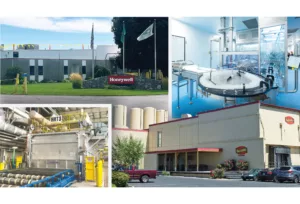Spine care now a backbone for neurology center
SHMC unit adds clinical work on back pain to earlier focus on stroke, tumor, epilepsy
Sacred Heart Medical Centers Inland Neuroscience & Spine Center, which opened last April with a strong emphasis on the treatment of strokes, now is developing a reputation for spine care.
The center, which occupies about 6,000 square feet of floor space on the ground floor of the Sacred Heart Doctors Building, is operated by the hospital, but has affiliations with nearly two dozen physicians and surgeons who specialize in neurological and neurosurgical care of the spine and brain and have subspecialties in epilepsy, stroke, and headaches.
Until a few weeks ago, no clinical work was done at the center; rather, it served as an education point for patients and a collaborative medical resource for physicians. With the hiring this summer of Dr. John F. Long, who specializes in physical medicine, rehabilitation, and osteopathy, the center now has become a busy clinic for the direct treatment of back and neck pain, says its executive director, Stephen Reichard.
Long treats patients who either arent candidates for surgery or are referred to him for pre- or post-surgical care. That treatment often includes physical therapy, performed either by the centers own physical therapist or by other clinics here. It also can include osteopathic techniquessuch as muscle retraining and strengtheningperformed by Long, as well as aquatic therapy, biofeedback therapy, and psychotherapy through referral to other specialists.
Already, the center is seeing about 100 patients a week, including about 20 to 25 new patients, says Long, who completed a residency this year at the Rehabilitation Institute of Chicago. Thats a far higher volume than the center expected to have this soon, and its now hoping to hire, perhaps by early next year, a physicians assistant and a physical-therapy assistant to help handle the load, Reichard says.
Currently, the center employs six people, including Reichard, Long, a physical therapist, a nurse, and two office personnel.
Reichard says one of the key impetuses for the center, and for the hiring of Long this summer, was a frustration shared by neurosurgeons here that many of the back-pain patients referred to them cant be helped by surgery, but have few places to turn for treatment. Care of the spine, he says, makes up about 80 percent of neuroscience, but only about 30 percent of people who suffer from spinal problems can be treated with surgery. The rest he says, usually see a family practitioner, a physical therapist, or a chiropractor.
Usually, spine care is a big hole in a community, outside of surgical intervention, Reichard says. Few other doctors in Spokane focus on nonsurgical treatment of the spine, he adds.
Long says his focus in treatment is on understanding the relationship between the bodys muscular and skeletal systems, and usually includes finding a way to use a muscles own energy to stabilize the spine. That can require a re-education of a muscle that hasnt been used in awhile because the patients body has adapted to reduce the pain from an injury or condition, he says.
When Long prescribes physical therapy, he says he doesnt do the usual eval. and treat method, which leaves up to the therapist what therapy to perform. Rather, he prescribes exactly what is to be done and what home exercises should be taught.
We emphasize the physical part of physical therapy, and not so much the ultrasound and other electronic methods of easing pain and loosening muscles, he says.
Also, Long doesnt prescribe narcotics for pain, believing that such drugs can lower a patients natural tolerance for pain. He says his philosophy, instead, is to use biofeedback and psychotherapy instead.
The center also has begun to convene a new spine group, made up of spine surgeons and neurologists, rehab specialists, and radiologistsabout 20 in allwho meet regularly to share information about cases and treatment plans with one another. Such sessions help health-care providers consult with one another to improve care, Reichard says. The Neuroscience & Spine Center also convenes such groups for the treatment of stroke, and is just starting a group focused on tumors.
In connection with the spine group, the center has begun collecting data on spine-related patients, including their health histories, treatment plans, and medical outcomes. That data soon will become a valuable treatment reference tool for physicians, he says, adding that the spine surgeons and neurosurgeons affiliated with the center collectively treat nearly 5,000 patients a year.
Stroke and epilepsy
The center already has a significant database from stroke patients, the collection of data for which began four years ago within Sacred Hearts neuroscience department, Reichard says.
That database was helpful in developing treatment protocols that now are commonly used here and that the center hopes to implement at rural hospitals in the region, he says.
Depending on the type of stroke, the protocols are targeted at patients who can be treated within six hours of the onset of symptoms, either with clot-busting drugs or by repairing an aneurism via the femoral artery or brain surgery. Both treatments are aimed at quickly returning oxygen-carrying blood to portions of the brain that have been denied oxygen due to the stroke, Reichard says.
Its during those first few hours when the most can be done for a stroke patient, he says.
The center is targeting about a half-dozen rural hospitals to push for use of such protocols in outlying areas. Those target hospitals all have imaging capabilities and broadband telecommunications lines that would enable doctors here to view images of a stroke patient at one of those rural hospitals and determine whether clot-busting drugs should be administered or the patient should be transported immediately to Spokane for a surgical procedure, he says.
As for epilepsy care, the center mostly serves as a facilitator of services provided at Sacred Heart and by its physician affiliates. For instance, the center set up a video communications system that enables Dr. Tim Powell, an epilepsy specialist, to view live video of an epilepsy patient at Sacred Heart from his office at Rockwood Clinic a few blocks away, Reichard says. That way Powell can observe a seizure that he otherwise might have missed.
The center also does long-term monitoring of epilepsy patients and manages some outpatient care of them at Sacred Heart, he says.
Eventually, the center hopes to become a clearinghouse for neurological care in the Spokane area, helping physicians and health-care providers coordinate and schedule patient care at various locations, while still providing medical resources to physicians and education to patients.
Related Articles



_web.webp?t=1764835652)
